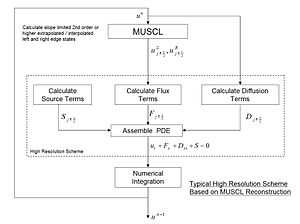High-resolution scheme
From Wikipedia, the free encyclopedia

Typical high-resolution scheme based on MUSCL reconstruction.
High-resolution schemes are used in the numerical solution of partial differential equations where high accuracy is required in the presence of shocks or discontinuities. They have the following properties:
- Second or higher order spatial accuracy is obtained in smooth parts of the solution.
- Solutions are free from spurious oscillations or wiggles.
- High accuracy is obtained around shocks and discontinuities.
- The number of mesh points containing the wave is small compared with a first-order scheme with similar accuracy.
High-resolution schemes often use flux/slope limiters to limit the gradient around shocks or discontinuities. A particularly successful high-resolution scheme is the MUSCL scheme which uses state extrapolation and limiters to achieve good accuracy – see diagram below.
See also
- Godunov's theorem
- Sergei K. Godunov
- Total variation diminishing
- Shock capturing methods
Further reading
- Harten, A. (1983), High Resolution Schemes for Hyperbolic Conservation Laws. J. Comput. Phys., 49:357–393.
- Hirsch, C. (1990), Numerical Computation of Internal and External Flows, vol 2, Wiley.
- Laney, Culbert B. (1998), Computational Gas Dynamics, Cambridge University Press.
- Toro, E. F. (1999), Riemann Solvers and Numerical Methods for Fluid Dynamics, Springer-Verlag.
| |||||||||||||||||||||||||
This article is issued from Wikipedia. The text is available under the Creative Commons Attribution/Share Alike; additional terms may apply for the media files.